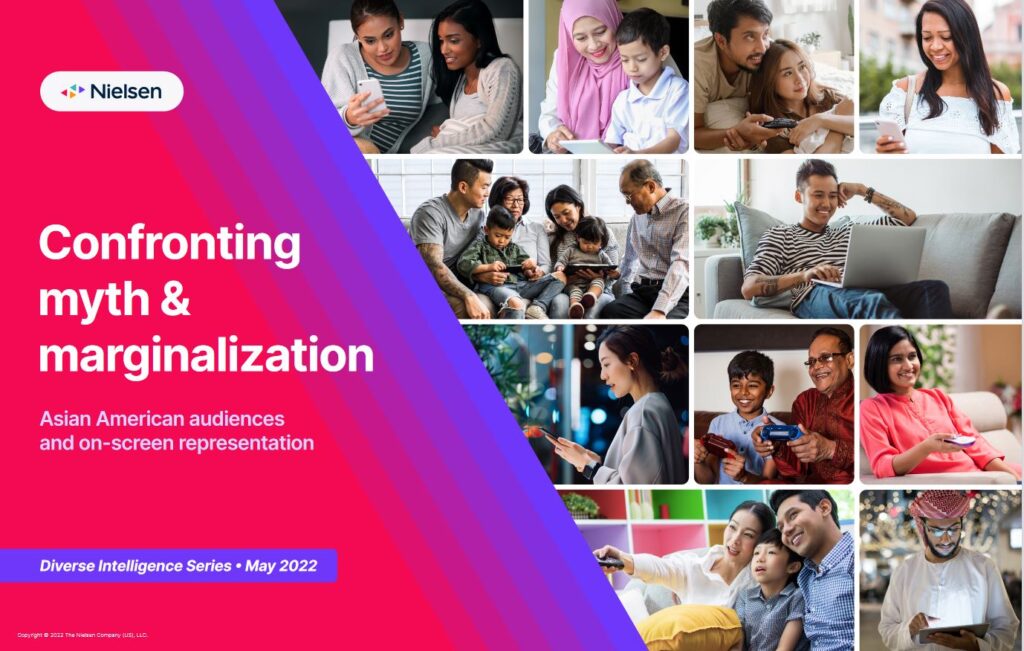By Rachel Tao, AsAmNews Intern
A study released Wednesday by Nielsen revealed significant growth in Asian American, Native Hawaiian, and Pacific Islander representation on screen in 2021, while highlighting the need for representation to increase further.
“The fact that Asian representation on screen is increasing means that the media industry has made progress in confronting the marginalization of Asians,” said Pat Ratulangi, Nielsen’s VP of Diversity, Equity, and Inclusion to AsAmNews. “The media industry has tremendous influence on people’s beliefs and biases. We must continue to hold ourselves accountable for accurate and nuanced stories about Asian Americans in the media.”
Overall, Asian representation across broadcast, cable, and streaming increased to 4.6% in 2021 from 3.5% in 2020. In particular, the report noted that there has been a large improvement in representation in the top 10 most-watched shows on broadcast and cable. While in 2020, none of the most popular shows had any Asian representation, in 2021, half of the top 10 programs had some level of Asian talent representation.
The 4 top shows all had at least 5.8% representation, and 3 of the 4 had a total Asian share of screen time of over 10% each. Asian women were present in three of the top 10 shows–NCIS, The Equalizer, and Yellowstone–and Asian men were present in two–Chicago Med and FBI.
LATEST STORIES
In the past two years, AANHPI representation in streaming has almost doubled, from 6.1% in 2020 to 11% in 2021, according to Nielsen. Across the top 1,500 shows in broadcast, cable, and streaming, streaming led the way with an 11% Asian share of talent, compared to significantly lower numbers for broadcast and cable; AAPI made up only 3.2% of broadcast talent and 2.7% of cable talent.
However, the presence of AAPI talent in popular shows like CBS’s FBI and The Equalizer, NBC’s Chicago Med, and FOX’s Asian-led The Cleaning Lady indicates the entertainment industry is beginning to respond to calls for AAPI inclusivity.

Still, two-thirds of Asian Americans feel there is not enough representation on TV, and consumers specifically desire more authentic content that highlights the Asian American experience’s richness. Over half of Asians surveyed feel TV portrayal of AAPI is inaccurate.
“The media industry continues to make progress in its inclusive
representation of Asian American, Native Hawaiian, and Pacific Islander
(AANHPI) characters, themes and narratives,” said Ratulangi.
“However, that representation on screen is still below the Asian population in the U.S. Now is an important time for the industry to highlight Asian characters, stories and experiences on screen through culturally inclusive
programming. Accurate representation on screen can lead to greater
understanding, inclusion, engagement and peace off-screen.”
There may be a shift happening in terms of representing the Asian American experience; in 2021, there was a greater diversity of themes in shows with Asian representation. These themes included friendship, teamwork, and creativity, contrasting with 2020’s more stereotypical themes, like intelligence, thoughtfulness, and goodness. Releases that helped bring in this thematic diversity include Squid Game, Turning Red, and Never Have I Ever.
In 2021’s most-viewed broadcast and cable programs, Asian women were most present in content featuring police procedurals and action dramas. Asian men were more featured in action and legal decision-making content, particularly in “model minority” roles. For example, in Chicago Med, Brian Tee plays Dr. Ethan Choi, an emergency room physician and infectious disease specialist, and in FBI, James Chen plays Ian Lim, an intelligence analyst. AAPI are most frequently seen in science fiction and action/adventure TV. On the other hand, Asian American inclusion in some genres, including romance and horror, is heavily lacking.

Another noteworthy distinction is that East Asian representation still leads the way in share of the screen, making up 2.7% of the 4.6%. South Asian representation constitutes 0.9% of TV, while Southeast Asian makes up 0.5% and Pacific Islander representation makes up only 0.2%.
Another interesting statement from the report is that Gen Z co-viewing on Netflix was 4.3 times higher than audiences overall. 8.4% of Asian American viewers aged 18-24 watched Netflix with someone aged 65-74, which shows that streaming offers more culturally relevant content appropriate for community elders. When Disney animated movie Turning Red was released, Asian viewers aged 75+ streamed it with kids at home at nearly 3 times the rate of viewers in the age group overall.

65% of Asian Americans are more likely to watch content featuring someone from their identity group. Considering over half of Asians surveyed by Nielsen said they are more likely to buy from a brand that advertises in shows featuring Asians, there is a clear incentive for advertisers and Hollywood to engage with this population.
Nielsen highlights that “Getting content right means connecting with a powerful consumer group.” According to the report, Asian Americans have over $1.3 trillion in buying power and 2.1 trillion minutes of viewing power per year. Additionally, the AAPI population has experienced a whopping 39% growth rate over the last decade, so that power will only grow.
Neilsen’s full report of the 2022 Asian American, Native Hawaiian, and Pacific Islander Diverse Intelligence Series can be found here.
AsAmNews has Asian America in its heart. We’re an all-volunteer effort of dedicated staff and interns. Check out our new Instagram account. Go to our Twitter feed and Facebook page for more content. Please consider interning, joining our staff, submitting a story or making a financial contribution.









